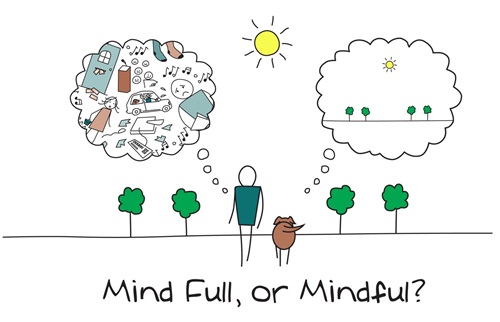Published:
March 27, 2020
Rapid heartbeat. Chest tightness. Trouble catching your breath. Sweatiness. Sleeplessness. Tensed muscles. Shakiness (inside and out). What do all these things have in a common? They are symptoms of anxiety. They impact your life and relationships. AND they can be controlled through mindfulness.
It is normal to experience anxiety during times of stress. We all got a pretty big dose of it during the pandemic and developed a variety of ways to cope--some positive; others not so much. But stress lives on well past COVID and is part of our everyday lives. Anxiety can take over your thoughts, causing you to worry about the future, obsess over the past, or contemplate things outside of your control. People often feel this anxiety in their physical bodies, as well as in their minds and thoughts. But by learning some skills and taking advantage of online apps, you can keep anxiety in check.
Practice Mindfulness
One way to reduce anxiety is to practice mindfulness. Mindfulness is a way of being, which brings your mind and thoughts back to the present moment, rather than focusing on the past, the future, or things you cannot control.
There are 3 key components of mindfulness:
- Purpose: Deliberately and purposefully directing your attention, rather than letting it wander. For example: Direct your attention to your breath or to the tension in a specific part of your body.
- Presence: Being fully engaged with, and attentive to, the present moment. If thoughts occur about the past or future, notice them simply as thoughts in the present moment (try to observe them).
- Acceptance: Being non-judgmental toward whatever arises in the moment. Do not judge thoughts, feelings, or sensations as good or bad, pleasant or unpleasant, but rather observe them until they pass.
Mindfulness Strategies
- Hold an ice cube in your hand until it melts. Notice the feelings and sensations in your hand as you hold the melting ice cube.
- 5-4-3-2-1
- Look for 5 things you can see
- Become aware of 4 things you can touch
- Acknowledge 3 things you can hear
- Notice 2 things you can smell
- Become aware of 1 thing you can taste
- Mindful breathing. Sit comfortably. Close your eyes (if this is comfortable). Notice what is around you. Then draw your attention to your breathing, noticing each breath in and out.
Common Roadblocks to Practicing Mindfulness
- “I can’t stop thinking.” Mindfulness is not about ignoring thoughts or not thinking, as this is nearly impossible. Don’t resist or focus on the thoughts. Notice them and observe them. Allow them to pass by.
- “I feel too restless.” It’s normal to feel this way when rushed. Take time to sit still.
- “I have uncomfortable emotions come up.” Allow feelings to arise without judgment. Try to focus on physical sensations that accompany emotions.
Helpful Apps
Headspace: Free with in-app purchases. Meditation has been shown to help people stress less, focus more, and even sleep better. Headspace is meditation made simple. It will teach you the life-changing skills of meditation and mindfulness in just a few minutes a day. The premium version currently free to health-care workers. Android and Apple platforms supported.
CBT-I Coach: Free and helps with sleep assessments, tools, and ways to “quiet your mind.” Includes some built in meditation, guided progressive muscle relaxation, and guided imagery resources. Created by the VA for those participating in Cognitive Behavioral Therapy for insomnia or those interested in improving sleep. Free on Android, Apple platforms.
Mindfulness Coach: Created by the VA for PTSD and is completely free. Has mindfulness training, exercises, and progress tracker. Free on Android, Apple platforms.
Oak/Calm: This app is found under the names ‘Oak’ or ‘Calm’ in the App Store. It’s a good introductory app for individuals who are beginning to explore relaxation and meditation tools. It has tools for relaxation, meditation and sleep promotion. This app is free for Android and Apple platforms.
Quirk: Free CBT application. Simple way to identify thoughts, type of thought, and challenge the thought. Android, Apple. Monthly fee after 7 day trial.
Provider Resilience: Created by the VA for professionals to self-screen for burnout, compassion fatigue and secondary stress. Includes vacation tracker, and self-care tools and tips. Free on Android, Apple platforms.
Virtual Hope Box (free): Contains simple tools to help with coping, relaxation, distraction, and positive thinking. Content can be personalized and includes videos on progressive muscle relaxation and deep breathing.

Do You Need Help?
If you are in need of immediate mental health help, it is available. Don’t hesitate to reach out:
Lancaster County Crisis Intervention:
717-394-2631